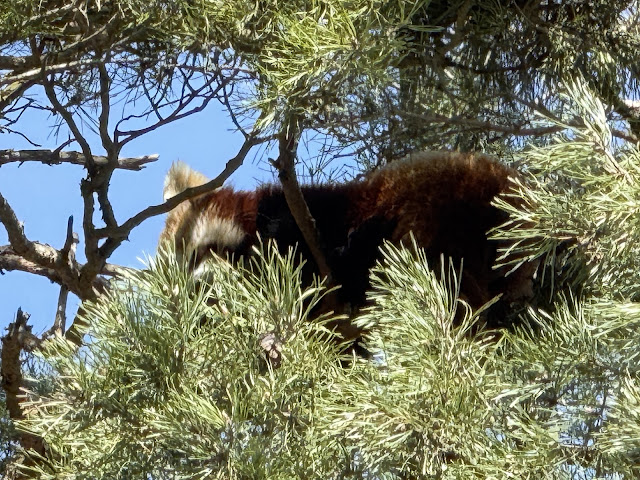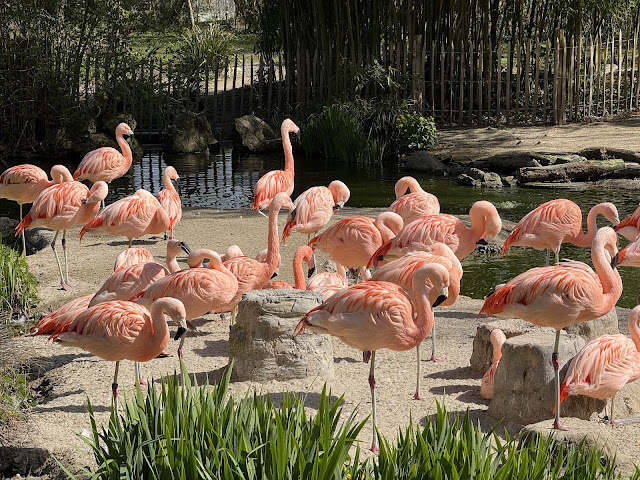Welcome to the last instalment of the April writing challenges UBC and Blogging from A to Z! Phew, this was an intense month, wasn't it.
As Europe’s first zoos paved the way for modern animal care, I felt Zurich Zoo deserved a place on Itchy Feet's map. 
Let’s dive into a visit that showcases a remarkable blend of conservation, education, and the undeniable charm of the animal kingdom.
Zurich Zoo's exhibits are organized by geographical regions, such as cloud forests, savannahs, and deserts, allowing animals to engage with environments that support their well-being.
Big Cats at “Panthera”: After a major renovation, the zoo introduced an innovative “rotation principle” in the Panthera big cat enclosure. Here, big cats, including Amur tigers like Akim, rotate between interconnected areas, ensuring they experience “well-dosed stress” while always being separated by species. This approach promotes mental and physical health for these majestic animals, such as the Siberian tiger, adapted to the harsh cold of Russia’s forests.
Baobab trees provide automatic feeders, helping zookeepers ensure balanced nutrition. The zoo also fosters awareness of biodiversity through its connection with the Lewa Wildlife Conservancy in Kenya. In an uplifting development, the zoo’s rhino family grew with the birth of Ushindi, a young rhino born in 2020. The zoo's large open spaces, such as the 5.6-hectare Lewa Savannah, offer a perfect environment for these majestic creatures.
During the pandemic, Zurich Zoo, like many others, was closed for an entire year, with no visitors allowed at all. While the lack of human presence was a challenge, it also provided an opportunity for zookeepers to enrich the animals' environment in other ways. Primates and other species were given behavioral enrichment, such as complex devices to free their food, helping them stay mentally engaged without human interaction.
Sadly, in 2022, the zoo experienced a tragic loss. Three young elephants—Umesh (2), Omysha (8), and Ruwani (5)—died from a herpes virus, a devastating illness that particularly affects young elephants between the ages of 2 and 8. Despite the best veterinary care, their deaths were a heavy blow to the zoo's elephant family.
However, a new hope arrived when 19-year-old Farha gave birth to her fourth baby, Zali, on April 19, 2025, a joyful moment that brought the zoo community together. Meet the cute young bull in this video:
The zoo also welcomed a new resident in the form of a lesser panda (red panda). Tiang Tang, a young female red panda, moved to Zurich Zoo alongside a male named Siddhi. The red panda is endangered due to habitat destruction and poaching. While visiting, I learned that despite their playful nature, they often prefer to hide in the treetops, making a photo opportunity a bit tricky. I was particularly looking forward to meeting this cute little animal. However, they didn't want to greet me.
Here are some fun facts: Same-sex pairs also come together if there are enough partners of the opposite sex. Homosexual penguins know the same behavioral elements in the partnership, during courtship and in the rearing of young as heterosexual animals. The only disadvantage is that they have to steal the eggs or young from heterosexual couples. This was observed at Zurich Zoo in 2009, for example, when two male king penguins stole the newly hatched young of a very experienced 20-year-old female. Reportedly the two thieves then took care of the young in a very exemplary and successful manner.
In reflecting on the role of zoos, I feel conflicted. On one hand, they provide an invaluable opportunity for people to learn about animals they might never encounter in the wild. I appreciate the zoo's role in conservation and education.
On the other hand, no matter how much effort goes into creating species-appropriate environments, a zoo can never fully replicate the vast territories that some animals need.
Think about it, a lion pride's territory ranges from 20 to 400 square kilometers (about 8 to 154 square miles). If the Zurich Zoo wanted to provide a truly expansive, species-appropriate territory for their lions, the required space would span a radius of about 10.1 kilometers from the city center. This means the entire population of Zurich, along with surrounding larger towns, would need to vacate the area to make room for the lions' natural habitat.
This raises an important question: How do we balance conservation with the ethical implications of confining animals to spaces that may not be truly representative of their natural habitats?
If you had a chance to chat with an animal at the zoo, which one would you choose, and what would you ask them about their habitat?
Thank you so much for keeping me company throughout this writing challenge - next week I'm going to post a review, keep your eyes open!















Great post. Love the pictures. Hard to say which zoo animal I would want to have a conversation with, but perhaps one of the oldest, to see if they feel conditions are getting better. I don't know life span versus how long any given animal has lived in captivity. Maybe the rhino, see how it feels about more living in zoos than are left in the wild.
ReplyDeleteI hope you're enjoying the A to Z Challenge. Please check out the giveaway on my blog.
J Lenni Dorner (he/him 👨🏽 or 🧑🏽 they/them) ~ Speculative Fiction & Reference Author and Co-host of the April Blogging #AtoZchallenge
Wow! 20 king penguins! That is cool. And I second you on the conflicting feeling about the role of zoos.
ReplyDeleteI loved the part about the penguins—especially the same-sex pair raising a chick! Such a heartwarming and surprising detail in a beautifully reflective post.
ReplyDeleteThank you for this post. I'm a huge animal lover and have always felt the conflict between being able to experience animals that I would otherwise never see, and seeing them confined in this way.
ReplyDeleteHow fascinating to hear about the homosexual penguins and having to steal eggs or newly hatched young to have their own family.
Tamara, what a great zoo! I kept wondering how big the whole zoo is, if the lion/savannah environment is over 5 hectares? I share your ethical concern over storing wild animals in a zoo. For elephants, this may be their only chance to live. For the others, I guess it's "Terms of Endearment". Thanks for another super post!
ReplyDeleteThe closest I've been to a zoo in many, many years is taking the Safari Trek ride in Disney's Animal Kingdom. Congrats on finishing the A-Z!!
ReplyDeleteDonna: Click for my 2025 A-Z Blog
It is interesting to learn about these animals, Tamara. But I am not a fan of zoos. It makes me sad to see animals in captivity.
ReplyDeleteOoh, I will look forward to next week's review. I really liked your videos. The penguin walk was my favorite! I feel conflicted, too, about zoos. I'm not sure which animal I'd want to interview, but I like the idea of getting their point of view. I have really enjoyed this series, by the way. I'm happy to have gotten to know Zurich, especially through comparison with the Itchy Feet map! I wonder what you'll choose as a theme for July...
ReplyDelete